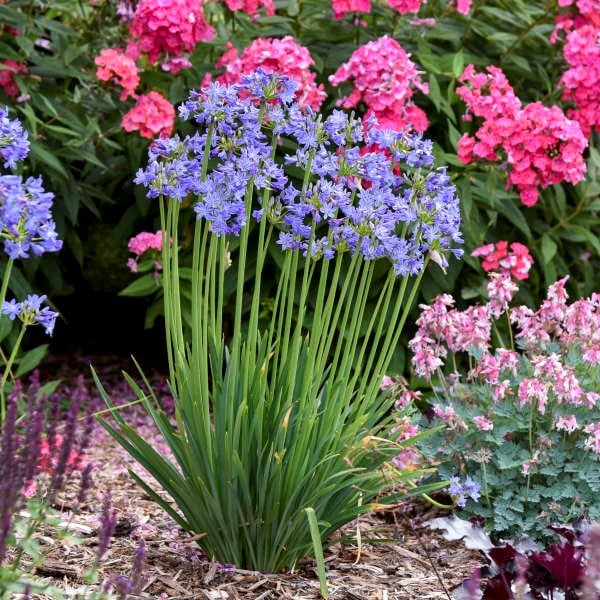Opening the Mysteries of Agapanthus: A Comprehensive Exploration of Selections, Planting Techniques, and Maintenance Practices

Agapanthus, usually shrouded in enigma due to its varied selection of varieties and intricate maintenance requirements, emerges as an enigmatic subject for lots of yard lovers. With a multitude of cultivars available, each boasting unique qualities and development practices, understanding the complexities of these plants can be both challenging and satisfying. As we explore the nuances of growing methods and explore the important maintenance techniques required to support these spectacular blossoms, a globe of possibilities unravels for those looking for to understand the art of cultivating agapanthus.
Agapanthus Varieties Demystified
Agapanthus selections display a diverse series of characteristics, making it essential for garden enthusiasts to recognize the differences between them for effective cultivation. Among one of the most prominent variants is the Agapanthus africanus, frequently known as the African Lily. This range is treasured for its striking blue or white blossoms and its capacity to prosper in both containers and garden beds. The Agapanthus praecox, or Blue Lily of the Nile, is one more preferred choice, boasting large spherical clusters of white or blue flowers atop tall stalks.
For those seeking a more compact option, the Agapanthus 'Peter Frying Pan' is an ideal option, with its smaller stature and fragile blue blossoms. On the various other hand, the Agapanthus 'Storm Cloud' range offers a significant style with its deep purple blossoms and dark vegetation (Agapanthus). Additionally, the Agapanthus 'Albus' attracts attention for its pure white blossoms, developing a spectacular comparison in any kind of garden setting
Understanding these distinctions can assist gardeners choose one of the most ideal Agapanthus variety for their specific requirements and choices, making certain a growing and lively yard screen.
Planting Agapanthus Like a Pro
When planting Agapanthus for optimum development and visual influence, careful attention to dirt quality and sunshine direct exposure is vital. Agapanthus grows in well-draining dirt with a somewhat acidic to neutral pH degree. Prior to planting, modify compressed or hefty dirt with natural issue such as garden compost to enhance drainage and fertility. Choose a planting area that gets full sunshine to partial color, as Agapanthus generally likes a minimum of 6 hours of sunshine daily for durable blooming. When growing, ensure the crown of the plant sits at soil level to stop rot and encourage healthy growth.

Essential Maintenance Tips for Agapanthus
To make certain the ongoing wellness and vitality of your Agapanthus plants, what key maintenance methods should be prioritized throughout the growing season? Agapanthus plants favor evenly moist soil yet can tolerate short durations of dry spell when established. Agapanthus plants benefit from department every couple of years to avoid overcrowding, improve blooming, and revitalize the plant.
Troubleshooting Common Agapanthus Issues
Identifying and promptly resolving common problems that might impact the health of your Agapanthus plants is necessary for keeping their vigor and elegance. Ensure your Agapanthus receive enough sunlight, preferably around 6-8 hours per day. By being watchful and addressing these usual problems next page without delay, you can aid your Agapanthus prosper and prosper in your garden.
Making Best Use Of Agapanthus Blooms: Expert Approaches
Enhancing the vibrancy and abundance of Agapanthus flowers needs a strategic technique that uses optimum expanding problems and professional techniques. To make the most of Agapanthus flowers, begin with picking the appropriate range for your area and wanted aesthetic. Agapanthus ranges vary in elevation, blossom shade, and bloom time, so pick one that matches your yard's requirements.
Correct growing is crucial for durable growing. Plant Agapanthus in well-draining dirt with enough sunshine direct exposure. Ensure the soil is abundant in nutrients and raw material to support healthy and balanced growth and respected blooming. Routine watering, specifically during the energetic growing season, is vital to avoid stress and anxiety and motivate flowering.
Feed Agapanthus with a well balanced fertilizer to advertise flowering. Deadheading invested blooms can redirect the plant's power right into creating brand-new flowers (Agapanthus). Split chock-full clumps every few years to invigorate the plant and stimulate flowering
Lastly, protect Agapanthus from parasites and diseases that can prevent blooming. Executing these professional methods will certainly aid you attain a stunning screen of Agapanthus blooms in your garden.
Final Thought
In verdict, the enigmas of agapanthus have been introduced with a thorough expedition of ranges, growing techniques, and upkeep techniques. By understanding the different ranges offered, growing them look these up correctly, and complying with important upkeep suggestions, one can effectively grow and appreciate these beautiful blossoms. By troubleshooting typical issues and executing experienced techniques, one can maximize agapanthus flowers and develop a spectacular garden screen. Through proper treatment and attention, agapanthus can prosper and thrive in any kind of yard setup.

When growing Agapanthus for optimal growth and aesthetic impact, thorough attention to soil quality and sunlight direct exposure is extremely important.To plant Agapanthus like a pro, area the plants according to Agapanthus their mature size to allow for proper air circulation and prevent overcrowding. Agapanthus plants benefit from division every few years to stop overcrowding, improve blooming, and renew the plant.In final thought, the mysteries of agapanthus have been introduced through a comprehensive expedition of ranges, planting strategies, and maintenance practices.